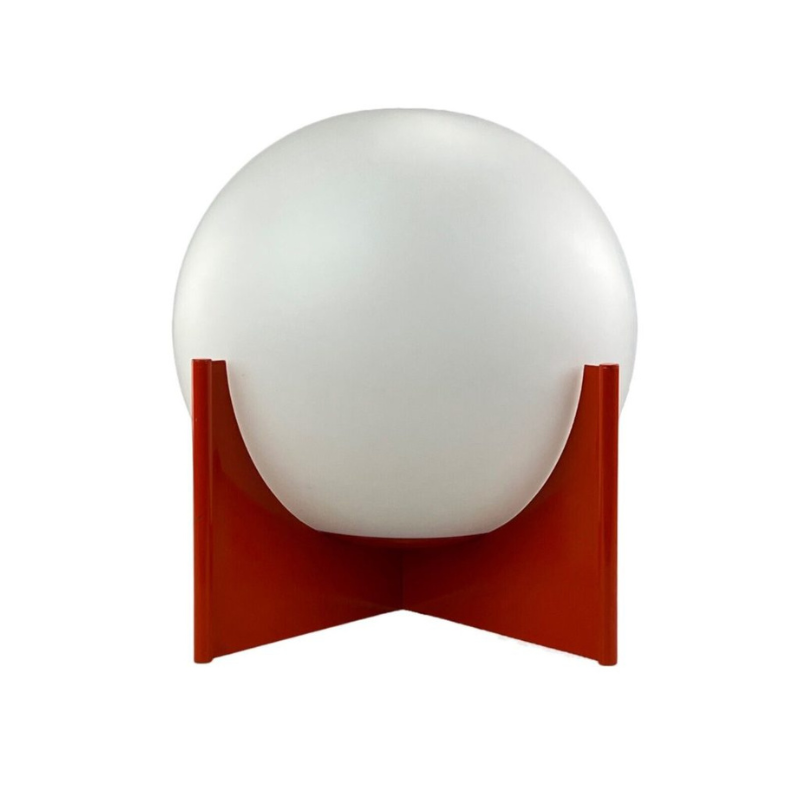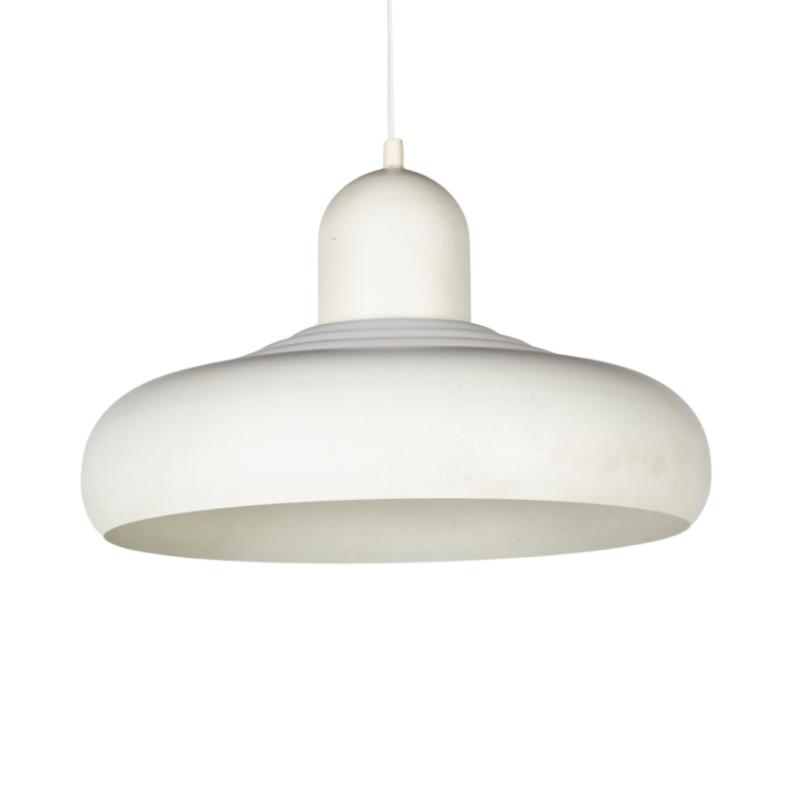Looking forward?....
...it is more like looking 46 years backwards!
Even when it was first produced and shown at the legendary furniture craftsmen exhibition in Copenhagen I did not like it. It is a nice technical challenge but the end result is not concealing the technical achievement...Technology should not be this visible.
The more important question is, what are designers doing right now that is so unsignificant that manufacturers digg deeper and deeper in the mid century history.
.....
On a side note regarding our continious discussions on original versus copies, this manufacturer(at least according to the text) has reversed the roles and starts with the copies...
"...Due to the complexity of the chair's design, only around 300 copies were originally produced..."
....I know it is not funny!
koen, thanks for your...
koen, thanks for your thoughtful response. I should apologize for not clearly stating the intent of the thread. It was simply to list events in design that would take place during 2009 and that we are looking forward to. This does not necessarily imply forward thinking in those events or designs. It could be a retrospective exhibition, a reopening, a reprint, or as in this case, a reissue. Anything goes, whether new or old.
With the GJ Chair, the manufacturer seems to be trying to stay true to Grete Jalk's original intent, and to the original chair itself. They have partnered with several institutions, including the museum that holds the original drawings and furniture, and they are using the same wood types as the originals.
As far as reissues go, I think this promises to be one of the better executed ones.
But I obviously like the chair, especially for its quirkiness and slightly outlandish form, and for how it reveals its construction.
[continued in next post...]
[...continued from previous post]
I am intrigued by your view that technology should not be visible. I think you are referring to manufacturing technology here, is that right? Could you elaborate?
To me, revealing the method of fabrication or assembly while keeping it functional and aesthetically pleasing makes for a more honest design. This I appreciate. It is difficult to achieve, but for the GJ Chair it works.
However, I agree that there is a more fundamental and interesting question here concerning the reason for all this retrospection. The simple answer of course has to do with return on investment and risk. Classics are safe bets. But I believe there is more to it. The symptoms can be seen not just in reissues but in the sheer amount of new work that is either retro influenced or new but totally irrelevant.
The clear break with convention to achieve something new seems rare. And haven't all the lasting radical breaks with tradition been a way to solve a problem? Most of what I see in design today does not solve any problem. All these new chairs that you can barely sit on, all the conceptual designs, all the space age future high tech new materials blahah. I doubt most of those designers really believe in their visions. It is just designers trying to be different for different's sake. So are reissues of designs that actually work and have a meaning such a bad thing in this context? Of course, one problem is that if we buy these products we send a mixed message to the manufacturers and designers. That is a risk.
Edit: Added a paragraph.
Although there...
...seems a lot to be said for hiding technology. One just has to imagine the Iphone or Ipod with a button for every function it has, or any other kind of other visual indication of all those intuitive functions that are now so well hidden and yet so accessible. But that is not exactly what you are intrigued by so let me stay with the subject.
Many years ago, Prof. France Vanlaethem and myself curated an exhibition on chairs. It showed a selection of chairs all the way back from Henri Van de Velde's Jugendstil chairs, Rietveld, FLW, Prouvé, Jacobsen, Friso Kramer etc. all the way to Gaetano Pesce's recent (at the time)chair experiments in cast resins. The theme of the exhibition was to explore the main motivations that inspired those chairs, from the coherence with the architecture they were designed for, to the search for ergonomic perfection, from manifests to technological innovation. One could draw a large variety of conclusions from that show, but one that I remember vividly was the impression that the chair has been such an emblematic object, ever since it became a wide spread object, that you can not resist the idea that it has been abused in a sense to serve all kind of other purposes that to be something to sit on. This chair to is, at least in my eyes, too much a demonstration of technical virtuosity that not always servs a functional or aesthetical purpose. To me the overlap of the two mouldings is simply crude and the folding edge, although showing some organic quality is in sharp contrast with the very straight line of bending (it is impossible to do otherwise). In other words technology can and should be shown in quite a number of cases but the compromises resulting from the technology should not be that explicit. Imagine the Barcelona chair with the crossing of the two flat bars showing the welding and filling of the four angles ?.
As you said, and I fully agree with that,: "To me, revealing the method of fabrication or assembly while keeping it functional and aesthetically pleasing makes for a more honest design". My take on this design is that the "while keeping it functional and aesthetically pleasing" left much to be desired. Of course it is still a very nice piece, but that's because mistakes made by talented designers often become minor mistakes?
Koen
I have to respectfully disagree. While this chair was not popular (and perhaps we could blame this on how few of them were created), I find it to be a successful design in terms of aesthetics. I have never sat in one, so I cannot vouch for it in functional terms.
I find this chair to be absolutely stunning. In addition, I look at it and marvel at what a challenge it's construction must be. The first time I saw this chair I knew nothing about it, or about Grete Jalk. But I loved it enough to make it my desktop on my computer. I loved it with absolutely no social strings attached ... who designed it, who likes it, how popular it is. I believe that it's unapologetic transparency of technology makes it that much more attractive.
How much more does it reveal it's technology than an Eames plywood chair? Except that it exploits the use of complex moldings to a more intense degree. The Eames plywood chairs expose the inner plys of the wood, they expose the screws that attach the back and seat, they expose what was an absolutely new technology with the shock mounts glued directly to the plywood.
I really don't see the difference between the level of technological transparency between Jalk and Eames. But this statement I am making assumes you like the Eames plywood chairs, and that may or may not be the case.
I am surprised with your statement about hiding technology. In my mind, that is contrary to good design.
Your statement that this design was a mistake is very bold, but you place a question mark behind it. Are you implying that you are not quite at ease with your own sentiments? And what difference does it make if it was a "slight" mistake?
If you don't find it's complex curves to be pleasing, I wouldn't say that it warrants such a statement. That is simply one design seen through your aesthetic leanings. You say it is a mistake with such authority. It smacks of the Baptists with their opinions to me, and I mean no disrespect.
I always embrace the idea that I could be wrong.
Dear Whitespike,
I am not familiar enough with Baptists to know what a Baptist opinion is, but I understand your comment. My comments are just that, comments. I hold very few opinions and when I have, I am willing to change them as quickly as I hear better arguments or get or more accurate information. In this case I find many great qualities. I love the fact that both the designer and the manufacturer were (in 1963) challenging the limitations of this technology, I love the proportions of the curves etc. But there are also things I do not like. The general statement that technology should be shown is just too strong for my understanding of design. The product exists in order to serve the user both by making the product comfortable, easy to use and pleasant to the eye etc. The fact that these goals are achieved by just one technology is an interesting input into the design, but not a quality as such. It can make the product more understandable, but sometimes it does not. Taking the Barcelona as an example again, the process of crossing these two flat bars and creating the impression that both are uninterrupted is a very messy technology. In another thread Poul Kjaerholm?s uncompromising attitude toward perfectly finished stainless steel frames is discussed. The reason why this was such an effort is simply that he insisted (very much like Mies v.d.Rohe) on hiding the technology by which they were made. I am sure that it was a major effort for P.Jeppesens at the time to build this chair and it is too bad that the earlier version got lost when their workshop burned, but challenging the technology as such is not enough to make a great design. 45 years later this chair has lost its technologically advanced status. Becker KB, whom I presume, is going to produce the formed parts has done far more challenging products than this one. I think it gives us an opportunity to reconsider it. To look at stability for instance, and other previously discussed points related to making a product by using one single technology. My conclusion in this case is that there are just a few too many compromises, to make this relevant design for 1963 still relevant in 2009. There is, I think, very little ?personal? in stating facts, and it is a fact that by using one single technology to manufacture a product, one has to make compromises. For instance the fact that the formed shell continues into the base or the support of the back rest prevented the designer (at least in 1963) to give the seat any other shape than a concave curve in one single direction. I am sure that it is not as comfortable as it would have been if the seat had been shaped separately from the base and the designer had been able to take advantage of that. By the way I can not see any disrespect in the fact that you would challenge these comments or correct the information that inspired them, and I see no disrespect in giving your arguments more strength by invoking the practices of a particular religion either.
I do appreciate the fact...
I do appreciate the fact that designing with only one technology present causes many compromises. A design may not be as successful as it could be if there were other technologies present. I get that, and that makes sense.
However, your statement, "45 years later this chair has lost its technologically advanced status" could be said about almost anything designed 50 years ago. This never seems to keep people from appreciating a design's aesthetic and history today, and it shouldn't. I can certainly see why someone would want this piece. While it may have had the opportunity to be strengthened with additional technology, it was a great exercise for using only one!
Besides, being technologically advanced, while it is a great measuring stick for design, it is certainly not the only parameter for good design. There are quite a few designers who use classic fabrication and building techniques to a good end. Ultimately, my favorite measuring sticks include a good use of materials, honesty of materials, build quality, proportion, scale, color, and, of course, the use of new technology.
I would say that Jalk create something technologically advanced, but perhaps, as you pointed out, it wasn't necessarily a mature decision for him to leave it singled out with no additional technique to improve it.
I still like it. So there 🙂
Just a small note....
to start the day (I hope I will find the time to reply seriously later) Grete Jalk is not a he but a she. I can't write her bio by memory but she should be in the DA index. She started off as an apprentice cabinet maker before starting serious studies in furniture design in Copenhagen. If I remember well she was teaching at her Alma Mater for a while, but apart from designing very well balanced pieces of furniture, she was also involved in "Mobilia" the best ever furniture design magazine. After a while she left and came back to join Per Mollerup again, but I do not remember exactly the dates. I also remember that she did a number of exhibitions on danish furniture design and danish design in general and was in some other capacity involved in the promotion of Danish design. She is without any doubt one of the great ladies of Danish design. I am sorry, but my memory is less and less reliable, I will have to look it up and ask Alix & Patrick to include her in the DA index.
Koen
Thank you for the information.
I have only seen the name attached to pieces, and have never known about the designer. I'm glad to have another favorite female designer. I would love to know more!!!
This is why I love this site. It looks like we have the off topics behind us. Back to the real chatter!
koen, thanks for...
koen, thanks for elaborating. I agree with your PK22 example. I am fascinated and slightly confused by the fact that I subscribe to both of these seemingly opposed aesthetic ideals. I will have to give it some more thought. While it does not change my thoughts on the Grete Jalk chair, its relevance is a valid question. This is a reissued chair. Would it be in question if it had been produced continuously?
The kaizen process you described in the garlic thread is one that I strongly approve of. Reissues of course often (and on purpose) ignore decades of potential user feedback and production technology advances. Unless the product was good enough from the start, this is a risk, or a missed opportunity. Still, there are many fantastic old designs waiting to be reissued or realised for the first time, but we don't know what their designers would do were they still around. Perhaps it is selfish to want them back?
Hej Gustaf....
I am still looking for reliable information on Grete Jalk, but while doing that I thought about this whole idea of re-editing and what it means in a larger historical context. I realized that I might have said "irrelevant" a little bit too fast. What about the hypothesis that true functionalism, not as a style but as long term cultural project has never really been abandoned. What if, after some unimportant side steps into different forms of so called post-modernism (all of them being rather superficial and heavily motivated by commercial rather than cultural ambitions) it just is about to reach that wider audience that so many mid century designers and architects hoped for and never reached. Let's remember that the mid century design world we so often talk about was a very closed and small community. Modernism at the time was systematically ignored by the media and forced designers and architects to edit there own magazines, organize their own awards etc. Domus was founded by Gio Ponti, the German and Swedish Form and ID magazine in New York were started and owned by the professional organisations of designers. These communities were so small that everybody knew each other and could not survive without each others support. Shortly after, the medias exploded and started to pay attention, so much attention that they started to generate their own "big" names but, their priorities were hardly those of the design community. So what if history is just unfolding itself slightly slower than we think, what if we had to wait until the start of this century to get the message of the first half of the previous one across. What if what we see now is simply modernism accepted and understood by a larger segment of the public? Would it not make sense to dust off the old drawings and introduce products that never went "in production" before? It might just be part of the disconnect between the younger generation of designers of which quite a number have abandoned the functionalist adventure, and the larger public that takes refuge in all kind of marginal styles.
If you need any help, please contact us at – info@designaddict.com










